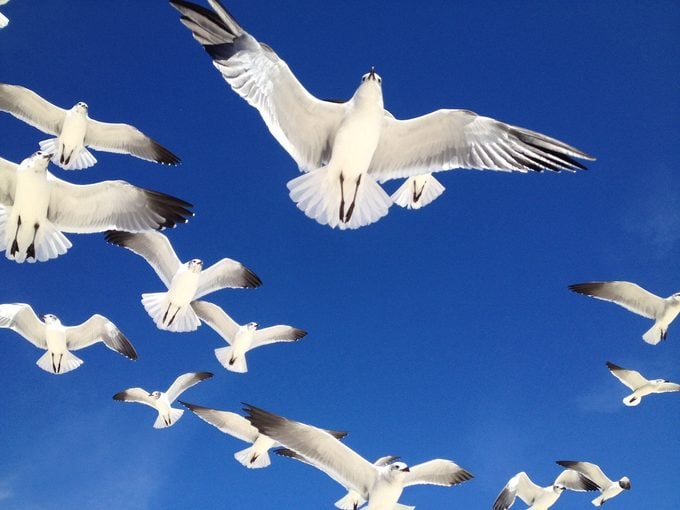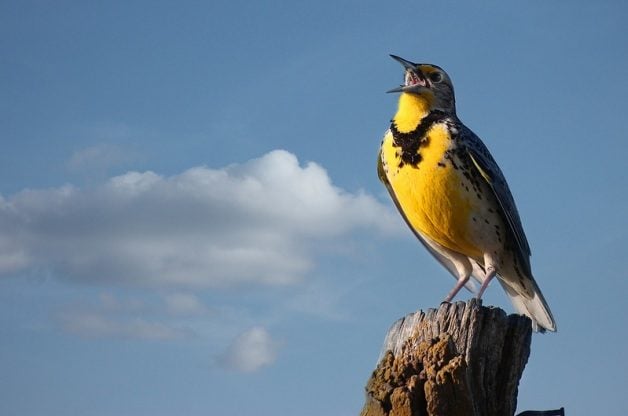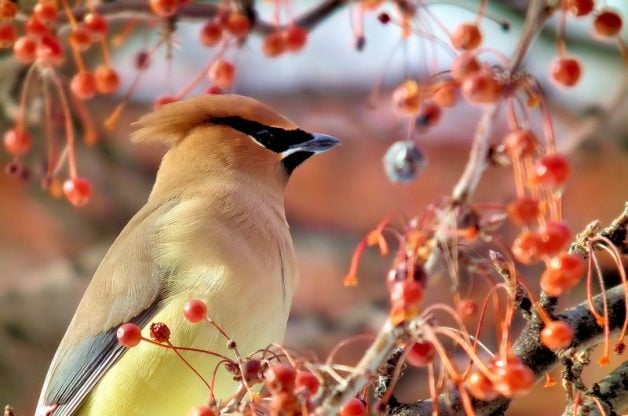How Do Birds Fly? Answers to Common Questions About Birds
Updated: Nov. 15, 2023
Learn fascinating facts about bird senses and bird behavior from a birding expert, and discover the truth about how and why birds migrate.

Do you know why blue-footed boobies have blue feet? Author Laura Erickson does, and you’ll find the answers to this and many other great questions in her book, The Bird Watching Answer Book. (For the record, Booby foot color is brightest when birds are well fed on nutritious fish—in captivity, when deprived of a good diet, the foot color grows noticeably duller within 48 hours.) Here are some additional fascinating bird facts from her book to enlighten any birdwatcher.
How do birds fly?
Birds’ wings are shaped to form an airfoil. When a bird moves forward through the air, the shape and curve of the wing cause the air to flow faster above the wing than below it. The faster air above lowers the pressure (drawing the bird upward) while the slower air below raises the pressure (pushing the bird upward). This force holding the bird up is called lift, and it requires that the bird be moving forward or facing into a fairly stiff wind. Learn how birds use feathers, beaks and feet.
Why are bird droppings white, and do birds “go” while flying?
If you examine bird droppings closely, you’ll see they’re made up of two parts—brownish dark green, which is the fecal matter, and the white, which is urine. Birds tend to release their droppings right before or during takeoff. On flights that last longer than a few minutes, they can and do release while flying.
How do birds know when to migrate?
From the time they hatch, migratory birds apparently respond instinctively, growing restless as the day length and angle of the sun change in spring and fall. By responding to day length, birds arrive on their breeding grounds at the best average time, regardless of weather conditions wherever the bird has wintered. In fall, this restlessness helps ensure that the journey will take place while rich food resources are most likely available. Some people assume that their feeders will entice birds to remain too long, but this restlessness ensures they do not. This is why you should keep feeders up for late migrating fall hummingbirds.
How do migrating birds know where to go and how to get there?
Some species, such as cranes and geese, learn their -migratory routes from their parents. They follow their -parents on their first flight south, and sometimes for part of the return trip north in spring, and then are on their own. Most birds, however, cannot depend on their parents. Young hummingbirds and loons migrate days or weeks after their parents have left, and yet the young birds know which way to head, how far to go and when to stop. The more we study the intricacies of orientation and navigation, the more miraculous it seems! Discover the answers to more bird migration secrets.

How do birds learn their songs?
Some scientists have devoted their careers to figuring this out, species by species. Some bird songs are hardwired into a bird’s brain. Virtually all flycatchers, including kingbirds and phoebes, fall into this category. Marsh wrens imitate elements of songs they hear. Sedge wrens seem to improvise their own song repertoires. American robins share some whistles with neighbors, so they apparently learn song elements from one another. Baltimore orioles may learn their songs from their fathers and neighboring orioles during their first summer. It’s possible to detect differences between songs of yearlings and older males, so orioles adjust their songs at least until they’re 2 years old. Learn how to identify birds by their song.
Do birds sing especially loud at dawn?
Yes, and they sing with more energy and variety. This “dawn chorus” actually starts an hour or so before dawn in spring and early summer. The chorus often begins with American robins singing a much more rapid, excited version of their daytime song. Chipping sparrows sing their songs at a frenetic pace, and many other birds sing with exceptional energy as well. Ornithologists don’t know exactly why birds sing so vigorously in the early morning. It could be that they have a lot of energy after a good night’s sleep or that in the dim light, territorial competitors and prospective mates don’t have much else to do but listen. Or it could be that the singing might attract potential mates that may have landed after a night of migration. Here’s 7 ways to be a better birder.

Can birds smell?
Birds don’t have a specialized nose but simply have nostrils, necessary for breathing and usually located near the base of the upper bill. But some species, including several ground birds and also some North American vultures and marine species, do have fairly large olfaction (smell) centers in their brains. Recent studies have shown that some songbirds, with relatively tiny olfaction centers in their brains, can smell. For example, cedar waxwings, which eat berries that can ferment and make them sick, have a better sense of smell than tree swallows, which probably can’t take in the odors of flying insects as they snap and swallow them in flight. Some homing pigeons use the sense of smell as one cue for navigating home. And some seabirds use their sense of smell to locate their nest. Learn how to attract waxwings with berries.
Do birds see colors?
Yes, and they can even see some wavelengths in the light spectrum that are invisible to humans. Birds use their excellent color vision to find food, such as ripe fruits and flowers. Their colorful plumage is important in courtship. Studies have shown that when given a choice, female birds often prefer males with the most colorful feathers. Birds can also detect polarized light that humans can’t see. Experiments show that pigeons and migratory songbirds use polarized light as a cue to help them navigate in the right direction.
If birds have “eagle eyes,” why do they crash into windows, power lines and guy wires?
Window glass is not only clear; it’s reflective. Sky and trees are mirrored in windows, and since there was no such thing as glass in the natural world for the millions of years that birds have been evolving, few wild birds have yet evolved any ability to notice it. Unlike branches and other natural structures, power lines and guy wires are straight and relatively thin, so they apparently appear two-dimensional, making it difficult for birds to gauge their distance from one until they’re crashing into it. Check out 5 ways to create a bird-safe backyard.
